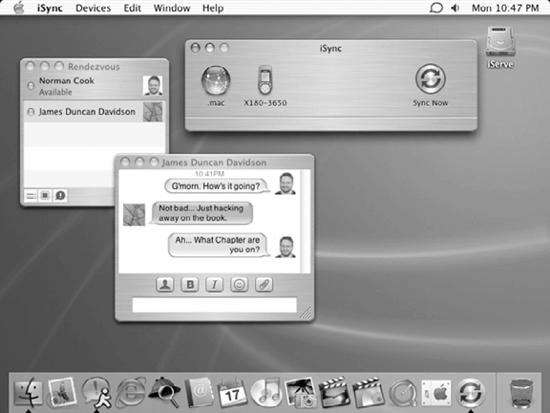The next release took Mac OS X to the next level. Unlike previous versions of Mac OS, Apple decided to put the codename, Jaguar, into the name of the product itself. On the box and at its web site, it is known as Mac OS X Jaguar. It is also the first release of Mac OS X to come as the default boot OS on every system Apple sold, marking an important step in the transition between the classic Mac OS and Mac OS X. The Jaguar desktop is shown in Figure 1-6.
Jaguar introduced the following features:
- Quartz Extreme
Building on the already powerful Quartz Compositor, Quartz Extreme performs most of its work in OpenGL, allowing it to take advantage of the enormous potential of modern graphics processors, and offloading the tasks from the computer’s CPU. With Quartz Extreme, all applications on the system have easy access to 3D capabilities, and this paves the way for later user interface improvements.
- Address Book
Previous versions of Mac OS X had a rudimentary contact database. Jaguar introduced a new system-wide contact database, along with a management application, called simply the Address Book. With its simple and elegant API, the Address Book can be incorporated into any application, and all the built-in applications on Jaguar, such as Mail and iChat, support it.
- Rendezvous
Built on the work of the IETF Zero Configuration (Zeroconf) effort, Rendezvous enables machines to discover each other without user intervention. This lets you share services with ease between machines on the same network and allows you to seamlessly connect to machines by setting up a local network and just hooking up cables or setting up an ad hoc wireless network. You can find out more about Zeroconf at http://www.zeroconf.org. Due to a trademark dispute, Rendezvous was renamed Bonjour with the release of Mac Os X Tiger.
- iChat
Another in Apple’s series of iApps, iChat is an elegant AOL Instant Messenger (AIM) -compatible application that leverages the strength of Rendezvous to allow chats between users on the local network. This is handy for ad hoc networks such as those at conferences and other events.
- Windows-compatible networking
Leveraging the capabilities of Samba, an open source software package for working with the Windows SMB file-sharing protocol, Jaguar can share its filesystems with Windows clients as well as mount Windows-based filesystems. Jaguar also introduced the capability to integrate with Windows Active Directory to ease the migration of Macs into Windows-dominated networks.
Even though Jaguar shipped with enough features to make most people happy, Apple didn’t stop there. After Jaguar was released, Apple released the following products for it:
- iCal
This personal calendaring application handles multiple calendars and enables sharing of those calendars via the Internet. Calendars can be published either through .Mac or to any server that supports the WebDAV protocol.
- iSync
A tool for synchronizing the address book and calendars on a Mac to mobile phones, PDAs, and the iPod. iSync allows information to be kept on multiple machines by synchronizing data against the .Mac service.
- iLife
iLife is a bundle of new versions of iPhoto 2, iMovie 3, and iDVD 2, along with already available iTunes 3, as a shrink-wrapped, boxed product available for sale in stores. Even though iLife has a cost associated with it, iPhoto, iMovie, and iTunes remain free downloads. Only iDVD is available exclusively through iLife.
- Safari
A brand new browser with a highly tuned rendering engine, Safari replaces Microsoft’s Internet Explorer as the browser of choice on Mac OS X. This browser fulfilled a real need as evidenced by the fact that there were 500,000 downloads of the public beta between January 7 and 9, 2003.
Get Running Mac OS X Tiger now with the O’Reilly learning platform.
O’Reilly members experience books, live events, courses curated by job role, and more from O’Reilly and nearly 200 top publishers.


